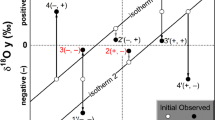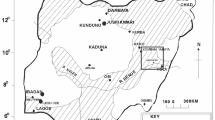Abstract
Unlike the release pressure process in shale gas exploitation, in this study, the concentration diffusion process is deeply discussed under constant temperature-pressure conditions, which aims to evaluate the preservation conditions of shale gas reservoirs in combination with isotopic fractionation characteristics. The isobaric diffusion experiment emphasized that decreasing pressure can lead to enhanced diffusion and isotope fractionation. The established mathematical model not only confirms the results of the simulating experiment, but also suggests that the contributions of Fick, Knudsen and surface diffusion to the migration of methane (including 12CH4 and 13CH4) vary in the geological evolution of shale reservoirs, which are mainly controlled by the pore system and gas pressure. Based on the analysis of specific samples of Longmaxi shale (r = 11.7 nm) and Niutitang shale (r = 1.3 nm), we propose that: 1) high pressure condition (> 20 MPa) can significantly limit Knudsen diffusion, which is the reason for reducing the total diffusion coefficient (DTotal) and isotope fractionation, while low pressure (< 10 MPa) and small pore radius (ca. 1 nm) can strengthen the fractionation; 2) pore connectivity and heterogeneity can lead to an order of magnitude change in DTotal, while the influence of temperature is relatively small. According to the mathematical model, it can be expected that enhanced dissipation intensity and isotope fractionation of shale gas may occur in the process of basin uplift and pressure relief, which can potentially be used for the evaluation of reservoir preservation.
Similar content being viewed by others
References
Afagwu, C., Alafnan, S., Mahmoud, M.A., and Patil, S., 2021, Permeability model for shale and ultra-tight gas formations: critical insights into the impact of dynamic adsorption. Energy Reports, 7, 3302–3316.
Cahill, A.G., Steelman, C.M., Forde, O., Kuloyo, O., Ruff, S.E., Mayer, B., Mayer, K.U., Strous, M., Ryan, M.C., Cherry, J.A., and Parker, B.L., 2017, Mobility and persistence of methane in groundwater in a controlled-release field experiment. Nature Geosciences, 10, 289–294.
Chen, G., Lu, S., Li, J., Wang, W., Tian, S., Shan, J., Hu, Y., Mao, J., and Han, X., 2015, The oil-bearing pore size distribution of lacustrine shale from E2S24 sub-member in Damintun sag, Liaohe depression, Bohai bay basin, China. Acta Geologica Sinica (English Edition), 89, 8–10.
Chen, L., Lu, Y., Li, J., Guo, X., Jiang, S., and Luo, C., 2020, Comparative study on the Lower Silurian Longmaxi marine shale in the Jiaoshiba shale gas field and the Pengshui area in the southeast Sichuan Basin, China. Geosciences Journal, 24, 61–71.
Chen, M., Kang, Y., Zhang, T., You, L., Li, X., Chen, Z., Wu, K., and Yang, B., 2018, Methane diffusion in shales with multiple pore sizes at supercritical conditions. Chemical Engineering Journal, 334, 1455–1465.
Choi, J.G., Do, D.D., and Do, H.D., 2001, Surface diffusion of adsorbed molecules in porous media: monolayer, multilayer, and capillary condensation regimes. Industrial & Engineering Chemistry Research, 40, 4005–4031.
Cui, X., Bustin, A.M.M., and Bustin, R.M., 2009, Measurements of gas permeability and diffusivity of tight reservoir rocks: different approaches and their applications. Geofluids, 9, 208–223.
Ekundayo, J.M., Rezaee, R., and Fan, C., 2021, Experimental investigation and mathematical modelling of shale gas adsorption and desorption hysteresis. Journal of Natural Gas Science and Engineering, 88, 103761.
Etminan, S.R., Javadpour, F., Maini, B.B., and Chen, Z., 2014, Measurement of gas storage processes in shale and of the molecular diffusion coefficient in kerogen. International Journal of Coal Geology, 123, 10–19.
Feng, G., 2020, High-temperature high-pressure methane adsorption and shale gas occurrence in Lower Cambrian shale, Upper Yangtze area. Ph.D. Thesis, China University of Mining and Technology, Xuzhou, China, 194 p. (in Chinese with English abstract) https://doi.org/10.27623/d.cnki.gzkyu.2020.000516
Goral, J., Walton, I., Andrew, M., and Deo, M., 2019, Pore system characterization of organic-rich shales using nanoscale-resolution 3D imaging. Fuel, 258, 116049.
Han, S., Sang, S., Duan, P., Zhang, J., Xiang, W., and Xu, A., 2022, The effect of the density difference between supercritical CO2 and supercritical CH4 on their adsorption capacities: an experimental study on anthracite in the Qinshui Basin. Petroleum Science, 19, 1516–1526.
Hendry, M.J., Schmeling, E.E., Barbour, S.L., Huang, M., and Mundle, S.O.C., 2017, Fate and transport of shale-derived, biogenic methane. Scientific Reports, 7, 4881.
Hu, D., Zhang, H., Ni, K., and Yu, G., 2014, Preservation conditions for marine shale gas at the southeastern margin of the Sichuan Basin and their controlling factors. Natural Gas Industry B, 1, 178–184.
Hu, W and Bao, J., 2018, Development trends of oil industry and China’s countermeasures. Journal of China University of Petroleum, 42, 1–10. (in Chinese with English abstract)
Hu, Y., Liu, G., Luo, N., Gao, F., Yue, F., and Gao, T., 2022, Multi-field coupling deformation of rock and multi-scale flow of gas in shale gas extraction. Energy, 238, 121666.
Kala, S., Turlapati, VY., Devaraju, J., Rasheed, M.A., Sivaranjanee, N., and Rave, A., 2021, Impact of sedimentary environment on pore parameters of thermally mature Permian shale: a study from Kommugudem Formation of Krishna Godavari Basin, India. Marine and Petroleum Geology, 132, 105236.
Kapoor, A. and Yang, R.T., 1989, Surface diffusion on energetically heterogeneous surfaces. AIChE Journal, 35, 1735–1738.
Kim, J., Chun, M., Jung, W., Park, H., and Sung, W., 2015, Optimum design of multi-stage hydraulically fractured multi-horizontal shale gas well using flow regime analysis. Geosciences Journal, 19, 481–487.
Kim, C., Jang, H., Lee, Y., and Lee, J., 2016, Diffusion characteristics of nanoscale gas flow in shale matrix from Haenam basin, Korea. Environmental Earth Sciences, 75, 350.
Lee, D.H., Kim, S.H., Choi, J., Kang, N.K., Hwang, I.G., and Shin, K.H., 2022, Geochemical signatures of organic matter associated with gas generation in the Pohang Basin, South Korea. Geosciences Journal, 26, 555–567.
Li, Q., Pang, X., Tang, L., Chen, G., Shao, X., and Jia, N., 2018, Occurrence features and gas content analysis of marine and continental shales: a comparative study of Longmaxi Formation and Yanchang Formation. Journal of Natural Gas Science and Engineering, 56, 504–522.
Li, W, 2018, Origins of fractured veins and characteristics of paleotemperature and pressure of fluid inclusions in marine shales of Fuling and Yichang regions. Ph.D. Thesis, China University of Geosciences, Wuhan, China, 103 p. (in Chinese with English abstract)
Li, W, Lu, S., Li, J., Zhang, P., Wang, S., Feng, W, and Wei, Y., 2020, Carbon isotope fractionation during shale gas transport: mechanism, characterization and significance. Science China Earth Sciences, 63, 674–689.
Li, W., Lu, S., Li, J., Wei, Y., Feng, W., Zhang, P., and Song, Z., 2021, Geochemical modeling of carbon isotope fractionation during methane transport in tight sedimentary rocks. Chemical Geology, 566, 120033.
Lu, J., Larson, T.E., and Smyth, R.S., 2015, Carbon isotope effects of methane transport through Anahuac Shale — a core gas study. Journal of Geochemical Exploration, 148, 138–149.
Lu, Y., Liang, B., Wang, C., Liu, C., and Ji, J., 2021, Shale gas exploration and development in the Lower Paleozoic Jiangdong block of Fuling gas field, Sichuan Basin. Oil & Gas Geology, 42, 241–250. (in Chinese with English abstract) https://doi.org/10.11743/ogg20210120
Ma, Y., Cai, X., Yun, L., Li, Z., Li, H., Deng, S., and Zhao, P., 2022, Practice and theoretical and technical progress in exploration and development of Shunbei ultra-deep carbonate oil and gas field, Tarim Basin, NW China. Petroleum Exploration and Development, 49, 1–17.
Milkov, A.V. and Etiope, G., 2018, Revised genetic diagrams for natural gases based on a global dataset of > 20,000 samples. Organic Geochemistry, 125, 109–120.
Pillalamarry, M., Harpalani, S., and Liu, S., 2011, Gas diffusion behavior of coal and its impact on production from coalbed methane reservoirs. International Journal of Coal Geology, 86, 342–348.
Rezaveisi, M., Javadpour, F., and Sepehrnoori, K., 2014, Modeling chromatographic separation of produced gas in shale wells. International Journal of Coal Geology, 121, 110–122.
Ruthven, D.M., 2006, Transport in microporous solids: a historical perspective. Part I: Fundamental principles and sorption kinetics. In: Conner, W.C. and Fraissard, J. (eds.), Fluid Transport in Nanoporous Materials. NATO Science Series II. Mathematics, Physics and Chemistry, Vol. 219, Springer, Dordrecht, p. 9–39.
Schloemer, S. and Krooss, B.M., 2004, Molecular transport of methane, ethane and nitrogen and the influence of diffusion on the chemical and isotopic composition of natural gas accumulations. Geofluids, 4, 81–108.
Shen, B., He, Z., Tao, C., Shen, J., Hu, Z., Li, Z., Cao, Y., and Chen, W., 2022, A mathematical diffusion model of carbon isotopic reversals inside ultra-tight Longmaxi shale matrixes. Petroleum Science, 19, 2014–2026.
Strąpoć, D., Schimmelmann, A., and Mastalerz, M., 2006, Carbon isotopic fractionation of CH4 and CO2 during canister desorption of coal. Organic Geochemistry, 37, 152–164.
Tinni, A., Fathi, E., and Agarwal, R., 2012, Shale permeability measurements on plugs and crushed samples. Presented at the SPE Canadian Unconventional Resources Conference, Calgary, 30 Oct.–1 Nov., SPE-162235-MS. https://doi.org/10.2118/162235-MS
Vinson, D.S., Blair, N.E., Martini, A.M., Larter, S., Orem, W.H., and McIntosh, J.C., 2017, Microbial methane from in situ biodegradation of coal and shale: a review and reevaluation of hydrogen and carbon isotope signatures. Chemical Geology, 453, 128–145.
Wang, G., Yuan, Y., Li, W., Wu, C., Zou, Y., Lu, L., and Li, L., 2021, Current situation and existing problems in research of natural gas diffusion coefficient. Natural Gas Geoscience, 32, 372–381. (in Chinese with English abstract)
Wang, S., Elsworth, D., and Liu, J., 2012, A mechanistic model for permeability evolution in fractured sorbing media. Journal of Geophysical Research, 117, B06205.
Wu, K., Li, X., Guo, C., Wang, C., and Chen, Z., 2016, A unified model for gas transfer in nanopores of shale-gas reservoirs: coupling pore diffusion and surface diffusion. SPE Journal, 21, 1583–1611.
Xia, X. and Tang, Y., 2012, Isotope fractionation of methane during natural gas flow with coupled diffusion and adsorption/desorption. Geochimica et Cosmochimica Acta, 77, 489–503.
Zhang, Y., Li, D., Sun, X., and Li, P., 2019, New theoretical model to calculate the apparent permeability of shale gas in the real state. Journal of Natural Gas Science and Engineering, 72, 103012.
Zhao, R., Xue, H., Lu, S., Li, J., Tian, S., Wang, M., and Dong, Z., 2022, Multi-scale pore structure characterization of lacustrine shale and its coupling relationship with material composition: an integrated study of multiple experiments. Marine and Petroleum Geology, 140, 105648.
Zhong, Y., She, J., Zhang, H., Kuru, E., Yang, B., and Kuang, J., 2019, Experimental and numerical analyses of apparent gas diffusion coefficient in gas shales. Fuel, 258, 116123.
Zou, Y., Wang, G., Lu, L., Zhu, H., Liu, G., Yuan, Y., Yang, H., and Jing, Z., 2021, Simulation experiment and mathematical model analysis for shale gas diffusion in nano-scale pores. Petroleum Geology and Experiment, 43, 844–854. (in Chinese with English abstract)
Acknowledgments
The study was supported by the National Key Research and Development Program of China (No. 2017YFC0603105).
Author information
Authors and Affiliations
Corresponding author
Additional information
Publisher’s Note
Springer Nature remains neutral with regard to jurisdictional claims in published maps and institutional affiliations.
Rights and permissions
About this article
Cite this article
Zou, Y., Wang, G., Tao, C. et al. Diffusion mechanism of deep shale gas and its carbon isotope fractionation: a combined simulated and mathematical analysis. Geosci J 27, 351–366 (2023). https://doi.org/10.1007/s12303-022-0035-9
Received:
Accepted:
Published:
Issue Date:
DOI: https://doi.org/10.1007/s12303-022-0035-9




